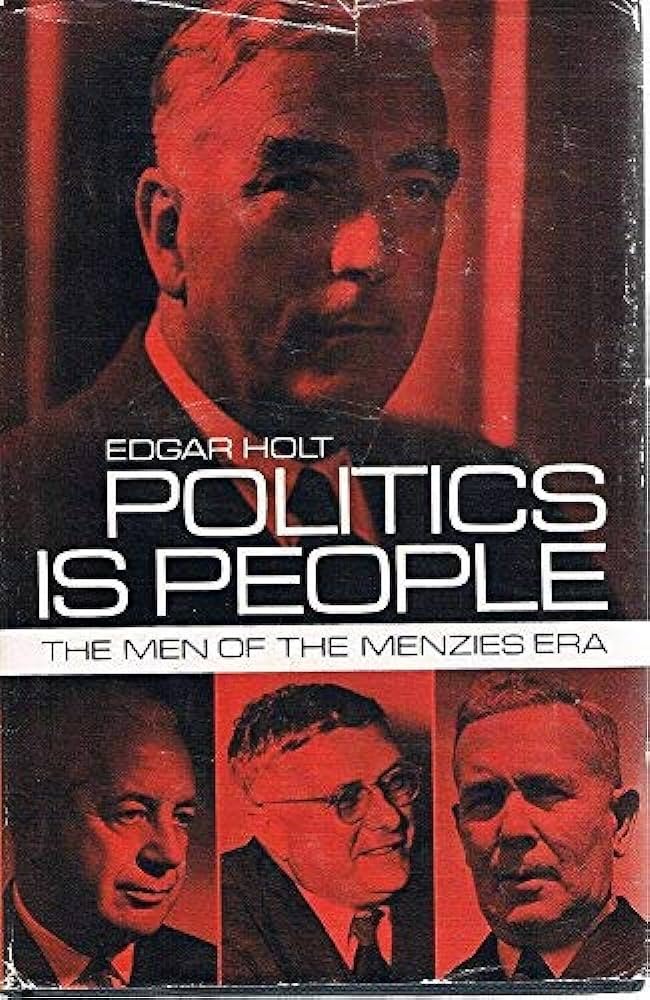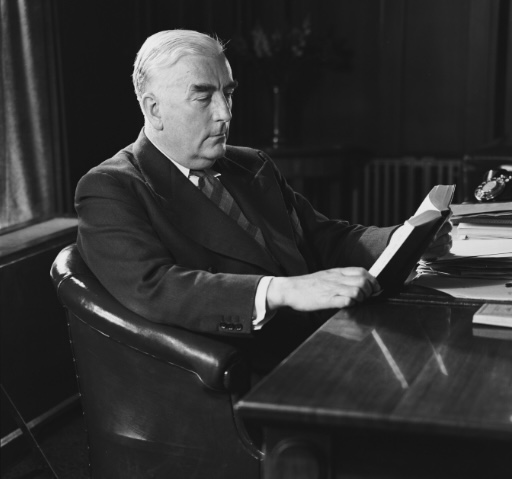Edgar Holt, Politics is People: The Men of the Menzies Era (1969)
Edgar George Holt was a journalist and public relations officer, who was a largely unsung hero behind Menzies’s political success.
Born in Lancashire in 1904, Holt’s family migrated to Australia when he was 9 and settled in Brisbane. After graduating from Brisbane State High School, he served a cadetship at the Daily Mail and worked for the Brisbane Telegraph. Then following some initial success, he moved to bigger ponds: first Melbourne, writing for first the Argus and later the Herald, and then Sydney, writing for the Daily and Sunday Telegraphs.
By 1939 Holt had been elected president of the Australian Journalists’ Association, and in 1944 he took a leading role in a newspaper strike, helping to produce a union newspaper in tremendously difficult circumstances. As this union involvement might indicate, Holt was initially an admirer of Curtin and Chifley. But he was put off by the latter’s attempt at bank nationalisation, and in November 1950 took up a job as federal public relations officer of the Liberal Party of Australia. At the time many pundits thought that Menzies might end up leading a one term government, hence there was not great competition for the role. But Holt seized on the opportunity, and in doing so would help to entrench Menzies as Australia’s longest serving prime minister.
As described in an ADB entry authored by Bridget Griffen-Foley, ‘Holt made the prime minister and his family the focus of party publicity, fostering the image of the fatherly “Bob Menzies” and then the statesmanlike “Sir Robert Menzies”’. He believed that public relations was ‘largely salesmanship, but one must know precisely what is to be sold’. Holt became astute at selling liberalism’s appeal to the dignity and freedom of the individual as the natural antidote to the horrific forms of totalitarianism which had so marred the twentieth century.
Although published after Menzies had retired, Politics is People serves as a great example of how Holt succeeded by selling the man and his conviction, as much as his policies. It documents Menzies’s career from his arrival in Canberra in 1934, showcasing Holt’s journalistic skill in painting an evocative picture. Take for example his description of the 1946 election, after Menzies had gone to great lengths to found the Liberal Party only for it to fall short at its first hurdle:
‘The setting is the Liberal Party’s State headquarters in Ash Street, Sydney. It is near midnight. The large, ground floor office is empty. The tables are littered and the floor is strewn with scraps of paper mutely recording some phase of the night’s agonizing count of votes. A few empty beer bottles and glasses tell a sad story. The air is still heavy with stale cigarette smoke. But those who had come to celebrate a victory had not remained to brood over a defeat’
This sense of melancholy adds weight to the contrasting victory in 1949. Take Holt’s enthusiastic description of the ‘49ers’, the vast class of new MPs that came to Canberra when the Liberals’ second election proved a success:
‘Increased membership of the Federal Parliament and the massive swing to the Liberal Party brought so many new faces to Canberra that the appearance of the House of Representatives was completely transformed. The old Canberra hands were a remnant of days gone by. Literally dozens of new parliamentarians crowded the lobbies when the new Parliament met. Their youthfulness was seen in eager, excited faces. Most of them had fought for their country a few years earlier, on land, on the sea and in the air. They were nearly all gallant as well as honourable members. In the early months of rapture they were consumed by a sense of purpose. The frustrations of parliamentary life were not yet apparent. In that early dawn of a new political era Robert Gordon Menzies walked among them like one of the mighty. The forty-niners were ready to remake Australia.’
For this crop of youngsters, Menzies was not just fatherly, he was head-masterly:
‘Menzies was a strong party leader, strong in the sense that he was the No. 1 man and expected 100 per cent backing for party decisions. Nearly always he got the backing, but not always with love! As his hair became whiter he took on the appearance of a headmaster. Bad boys were not hoisted for a flogging but they had the feeling they were standing in a corner with backs to the class. Bad boys who talked back drew nasty pictures about the Head. He ignored them. He never made prefects of them. With others, he could be the Head who made embarrassingly cutting remarks.’
By the end of the book it is clear that Holt’s experiences had transformed him. He was no longer just a salesman of Menzies; he was a genuine admirer of how the man operated:
‘If a political campaign may be looked at, tactically, as a military operation directed by a leader who selects his battlefield and determines the outcome with foresight and singlemindedness, Menzies deserved a marshal’s baton. Temperamental like others who enjoyed supreme command, impatient when minor campaign defects affected him personally, and touchy as a chutney colonel if a junior officer suggested a variation in riding instructions, he was — in spite of mortal frailties— an admirable C-in-C. For this reason: he surveyed the field before joining battle, made his plans (and they were always simple), and never departed from them.
It was always a pleasure to discuss with him the details of a Federal campaign. Sometimes the preliminary talks between the Prime Minister and his advisers occurred months before the official opening of a campaign. Professionals who had worked with him for years understood the exercise. They knew how he liked to approach the problem; they knew the policy background; they saw the emerging issues; they had assessed the political climate. And so, they said, this is how we see the campaign. What they saw they put down in half a dozen short paragraphs. They didn’t write a long report or compose a lecture. It was the stark ABC of a campaign theme.’
Sign up to our newsletter
Sign up for our monthly newsletter to hear the latest news and receive information about upcoming events.


